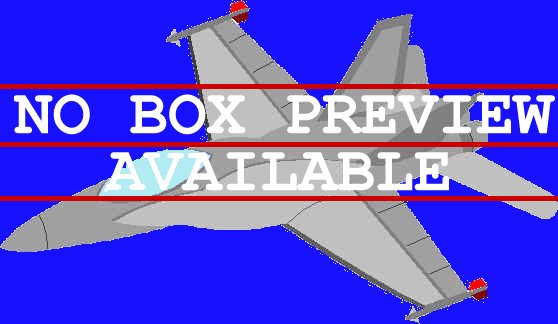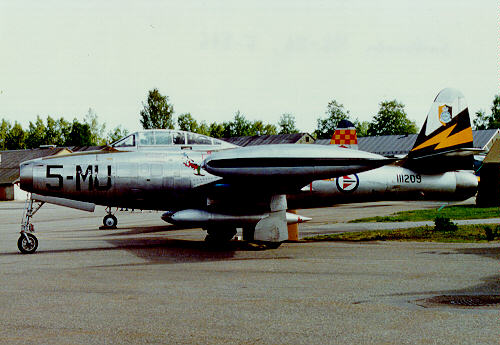
HELLER 1:72 REPUBLIC F-84G THUNDERJET

Reviewer: Myself (braithy@bigpond.com)
The Republic F-84 family is renowned for it's involvement in the Korean war in the 1950's as well as it's series of aircraft with the "Thunder" prefix. The F-84G was a variant described as being out of sequence because it was a Thunderjet straight wing model (the F-84F being the first swept wing Thunderstreak version), the last of that particular sub-family. It was the first fighter aircraft able to deliver tactical nuclear weapons because of incorporated system advancements. It also featured the multi-framed canopy which differed from earlier Thunderjet variants (although these were subsequently fitted with the multiframes retroactively) plus a retractable inflight refuelling probe. F-84G's served in Korea mainly as air to ground attack aircraft and 1900 G-models were exported to overseas customers, many of whom accepting the F-84G as their first post-war jet aircraft frontline fighter, including West Germany.
Heller's kit covers the export F-84G model with the option of making a French or Norweigan example. I actually got the kit as a birthday present (I did ask for an F-84G) but wanted a USAF model to do up in Korean colours! Oh well, you can't be picky when someone else is doing the shopping, so I have decided to conform to one of the kit's examples and the Korean model will have to be backlisted for future projects. I've always been a big fan of Heller kits, they are generally good quality, parts fit well, accurate in completion and enjoyable to build. This kit was no exception.
On opening the box you are presented with 4 sprues of 43 parts which are all allocated for use in this kit (except one of the speed brake covers). There is no flash encumbering the parts, it's coloured in a medium grey plastic - with a metallic complexion, lightweight plastic and finely raised panel lines with quite good detail scribed thereon. The only concerns are a fair few sink marks and ugly looking plastic areas but these should iron out with the right attention.
Instructions are set out on one A3 sized sheet folded to make an A4 sized booklet with an extra A4 sheet listing all the keys to the various symbols used in the instruction steps. There are only 6 instruction steps, as there isn't a lot of parts to attach, and includes some extra diagrams for assistance with cockpit and undercarriage alignment. Paint codes are listed with Humbrol reference numbers which is the most severe criticism of the kit, not because they use Humbrol reference (I use Humbrol myself so it's fine for me) but no names are actually given, only the numbers. This makes it hard if you're using another brand of paint and don't have a cross-reference guide. To cut to the chase, here are the Humbrol paints used in this kit plus their names (bear in mind that Humbrol have assigned these names and they may differ with other paint providers): Hu11 (Silver); Hu25* (M/Blue); Hu60 (M/Scarlett); Hu64 (M/Light Grey); Hu85 (G/Coal Black); Hu120 (M/Light Green) & Hu123 (S/Extra Dark Sea Grey). The codes used are M/ = Matt; G/ = Gloss; S/ = Satin; *=Norway example only. You can also see my links page to get Humbrol codes.
Construction as always starts with the cockpit and this is quite reasonably detailed, even including the fairings on the panel behind the seat and HUD unit. A seat fits into a 'bath tub' unit with a joystick also provided (no figure) and an instrument panel. Unfortunately (other than some scribed detail on the instrument panel) there are no dials or decals to act as the instruments so this will need to be sought from an aftermarket source or scratchbuilt. The nosewheel unit which affixes onto the air intake interior is subject of the next step. You soon move onto joining the fuselage halves to encase the cockpit unit and intake/nosewheel section with no fit problems to speak of. Using rubber bands as clamps there was no hassle in getting the fuselage halves to join properly. One criticism as far as accuracy is concerned is that the pitot (?) tube extends out of the intake too much. Side on you should only be able to see the very end of the tube but on the model almost a third of it sticks out. No problem just sand it back!
In the final step you attach all the exterior components like the wings, canopy, etc and perhaps the only crictism here is that the instructions only show you the assembly of the port side. While it gives you the numbered parts for both sides it's sometimes difficult to exactly work out which part is port and which one is starboard. Assigning the rule that the second numbered part is the starboard side wasn't always correct, but nonetheless it is still quite straightforward and dry fitting the parts first will avoid any problems this could otherwise cause. Another point of inaccuracy was that the F-84G by my recollection (and reference sources) has four guns in the nose and two on the wings, however the kit allocates three guns on the wings, with two on the starboard side. Using a bit of putty this was also easily rectified.
I had no problems with the fits, and only needed a small amount of putty to fill in very small gaps between wing roots and undercarriage doors (as mine was configured as an in-flight model). As previously mentioned the kit replicates two example aircraft, one French plane based in St Dizier 1955 and a Norweigan 331 Sqdn example, 1957, with both aircraft in recommended silver finish overall. I chose the Norweigan version and used Humbrol Decalfix to adhese the decals to the aircraft. The decals were a bit thin and brittle, and I conveniently snapped one, but I was able to line it up and there was no problem. The decals fixed like a charm and really makes the aircraft look nice, especially in an alternative AF. There are only two optional positional changes to the aircraft being an open canopy and speed brake extended outward.
Overall this was a pretty easy kit to build and would suit modellers right down to the novice. Other than the pointed out criticisms above I think that the model is very good on accuracy and would certainly recommend it as a good buy. I was particularly pleased with the external detail scribed on the aircraft body and HUD with fairings included in the cockpit.
Related Review: Italeri 1/72 F-84F Thunderstreak
Back to home
Kit Review Index: 1/72
1/48

Photo Credit: Ragnar Eckhoff,
taken at an airshow at Gardermoen in 1994
IPMS Norway: http://www.oocities.org/CapeCanaveral/Hangar/1375/
The Heller kit reproduces French and Norweigan version, an example of the latter being displayed above - although exact decals differ. Note the inline fuel tanks are included in the kit